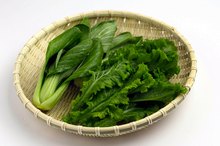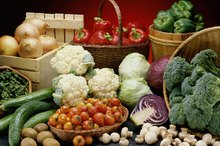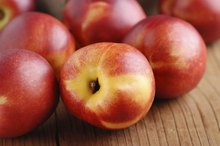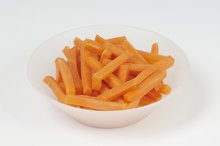Glycemic Index of Cabbage
A member of the cruciferous vegetable family, cabbage deserves a place of your plate. Unfortunately, the humble cabbage's stinky reputation overshadows its true nature as a nutritional powerhouse. Whether red, green or the savoy variety, cabbage can add crunch and a unique flavor to dishes, all while keeping your blood sugar levels low and steady. Additionally, cabbage is a healthy source of fiber, vitamins C and A, and phytonutrients -- polyphenols and glucosinolate -- believed to be protective against cancer.
The Glycemic Index: An Overview
The glycemic index is a ranking system indicating how quickly a food's carbohydrate content is broken down and absorbed into the body. A food's GI will vary based on fiber content, level of processing and type of carbohydrate. For example, a slice of white bread, which is refined and low in fiber, has a higher GI than a slice of wheat bread that is less refined and higher in fiber. Additionally, a complex carbohydrate like lentils have a lower GI compared to a simple carbohydrate such as a banana. Each food's GI is measured as a number that can then be classified as high, medium or low. A high GI is 70 or more, a medium GI is between 56 and 69 and a low GI is 55 or less. Foods with a high GI enter the body more rapidly, resulting in higher blood sugar values.
- The glycemic index is a ranking system indicating how quickly a food's carbohydrate content is broken down and absorbed into the body.
- Additionally, a complex carbohydrate like lentils have a lower GI compared to a simple carbohydrate such as a banana.
Glycemic Index and Health
Nutritional Value of Cooked Cabbage
Learn More
Eating foods with low GI can help keep your blood sugar levels low, minimizing damage to your blood vessels. In normal metabolism, your body is able to keep your blood sugar within a narrow range no matter what or how much you eat. However, with pre-diabetes or diabetes, your body is no longer able to manage that blood sugar stability and blood sugar levels can get dangerously high. Chronically high blood sugar levels can result in damage to blood vessel walls and lead to long-term complications like heart disease and kidney failure. In a meta-analysis published by " Diabetes Care" in 2003, lead researcher Dr. Jennie Brand-Miller and colleagues found that a low GI diet helped lower blood sugar levels in people with diabetes 1. Adding low GI foods to your diet, like cabbage, can be a first step towards improving your health.
- Eating foods with low GI can help keep your blood sugar levels low, minimizing damage to your blood vessels.
Glycemic Index of Cabbage
Cabbage has a very low GI, ranging from zero to 10. The University of Sydney maintains an extensive GI database and does not include cabbage in its list as it has negligible carbohydrates 2. As explained by the university, foods with few carbohydrates like meat, some vegetables and alcohol do not exert a measurable difference in blood sugar levels, therefore, are considered a no-GI or low-GI food. Since cabbage is a low-calorie, high-fiber food, 1 cup of raw cabbage provides a mere 5 grams of carbohydrate and 2 grams of fiber. Adding cabbage to your diet will help lower the overall GI of your meal.
- Cabbage has a very low GI, ranging from zero to 10.
- As explained by the university, foods with few carbohydrates like meat, some vegetables and alcohol do not exert a measurable difference in blood sugar levels, therefore, are considered a no-GI or low-GI food.
Adding Cabbage to Your Diet
List of Low Insulin Index Vegetables
Learn More
Cabbage is a sturdy vegetable enjoyed as a staple in many countries and is available year-round in most areas. To add this low-GI food to your diet, consider adding both raw and cooked versions to your meals. Raw cabbage is crunchy and can be slightly bitter; try adding finely sliced red cabbage to a garden salad for a dash of color. If you prefer your cabbage cooked, toss the thinly sliced vegetable into a stir fry or soup and cook until softened. To avoid the sulfurous smell associated with cooked cabbage, cook until just tender. Overcooking cabbage is what results in the unpleasant smell many associate with the vegetable.
- Cabbage is a sturdy vegetable enjoyed as a staple in many countries and is available year-round in most areas.
- If you prefer your cabbage cooked, toss the thinly sliced vegetable into a stir fry or soup and cook until softened.
Related Articles
References
- "Diabetes Care"; Low–Glycemic Index Diets in the Management of Diabetes; Jennie-Brand Miller et al.; August 2003
- University of Sydney GI database
- USDA Nutrient Database
- Cabbage, raw. FoodData Central. U.S. Department of Agriculture. Published April 1, 2019.
- NWAC diabetes self-management toolkit for Aboriginal women - fact sheet: Glycemic index. Native Women's Association of Canada. Updated 2012.
- Corliss J. Folic acid, a B vitamin, lowers stroke risk in people with high blood pressure. Harvard Health Publishing, Harvard Medical School. Updated 2015.
- Moore M. 4 types of foods to support memory. Academy of Nutrition and Dietetics. Updated 2020.
- Nosrati N, Bakovic M, Paliyath G. Molecular mechanisms and pathways as targets for cancer prevention and progression with dietary compounds. International Journal of Molecular Sciences. 2017;18(10):2050. doi:10.3390/ijms18102050
- Vitamin A fact sheets for health professionals. National Institutes of Health. Office of Dietary Supplements. Updated 2020.
- The top 10 worst foods if you have diabetes. Cleveland Clinic. Updated 2020.
- Oral allergy syndrome (OAS) or pollen fruit syndrome (PFS). American Academy of Allergy, Asthma & Immunology. Updated 2020.
- Violi F, Lip GY, Pignatelli P, Pastori D. Interaction between dietary vitamin K intake and anticoagulation by vitamin K antagonists: Is it really true?: A systematic review. Medicine (Baltimore). 2016;95(10):e2895. doi:10.1097/MD.0000000000002895
- Cabbage. University of Illinois Extension, Watch Your Garden Grow. Updated 2020.
- Cabbage. University of Maryland Extension. Updated 2020.
Resources
Writer Bio
Melissa Paton is a registered dietitian with a B.S. in dietetics and a Master of Science in human nutrition, both from Arizona State University. She has been published in "Swimmer's World," "The Arizona Republic" and on AZCentral.com.









